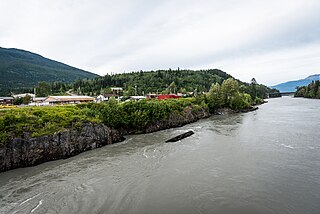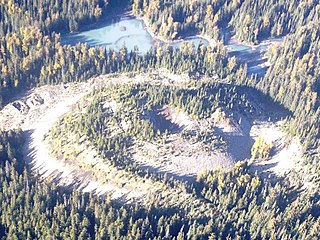Related Research Articles

The Nass River is a river in northern British Columbia, Canada. It flows 380 km (240 mi) from the Coast Mountains southwest to Nass Bay, a sidewater of Portland Inlet, which connects to the North Pacific Ocean via the Dixon Entrance. Nass Bay joins Portland Inlet just south of Observatory Inlet.

The Nisga’a (Niska), often formerly spelled Nishga and spelled in the Nisga'a language as Nisg̱a’a, are an Indigenous people in British Columbia, Canada. They reside in the Nass River valley of northwestern British Columbia. The origin of the term Niska is uncertain. The spelling Nishga is used by the Nishga Tribal Council, and some scholars claim that the term means 'people of the Nass River'. The name is a reduced form of, which is a loan word from Tongass Tlingit, where it means 'people of the Nass River'.
The Victoria Cross Ranges are a set of mountain ranges in the Canadian Rockies, located to the northwest of Jasper. Of the 19 peaks contained within this range, five are named after Canadian recipients of the Victoria Cross. The area of the ranges is 678 square kilometres (262 sq mi).

Princess Royal Island is the largest island on the North Coast of British Columbia, Canada. It is located amongst the isolated inlets and islands east of Hecate Strait on the British Columbia Coast. At 2,251 square kilometres (869 sq mi), it is the fourth largest island in British Columbia. It was named in 1788 by Captain Charles Duncan, after his ship Princess Royal.

Seven Sisters Provincial Park and Protected Area is a provincial park in British Columbia, Canada, protecting part of the Howson Range between Hazelton and Terrace and comprising approximately 27,200 hectares.

The Hazelton Mountains are a grouping of mountain ranges on the inland lee of the Kitimat Ranges of the Coast Mountains in northwestern British Columbia, Canada, spanning the area of Hazelton south to the Nechako Reservoir. Defined by the British Columbia geographic names office, they span from the Nass River to the Nechako Plateau, and between the Coast Mountains and the Bulkley River, they are considered by geographers to be part of the Interior Mountains complex, though in local perspective they are considered to be part of the Coast Mountains. They are neighboured on the west by the Kitimat Ranges and on the east by the southernmost section of the Skeena Mountains; beyond the Nass River, which is their northern boundary, are the Boundary Ranges of the Coast Mountains. To their southeast is the Nechako Plateau, including the Quanchus Range on the near-island between Ootsa and Eutsuk Lakes of the Nechako Reservoir.

The Tseax Cone, also called the Tseax River Cone or the Aiyansh Volcano, is a young and active cinder cone and adjacent lava flows associated with the Nass Ranges and the Northern Cordilleran Volcanic Province. It is located east of Crater Creek at outlet of Melita Lake, southeast of Gitlakdamix and 60 kilometres (37 mi) north of Terrace, British Columbia, Canada.

Nisga'a Memorial Lava Bed Provincial Park is a provincial park in the Nass River valley in northwestern British Columbia, Canada, about 80 kilometres north of Terrace, and near the Nisga'a Villages of Gitlakdamix and Gitwinksihlkw.
The geology of the Pacific Northwest includes the composition, structure, physical properties and the processes that shape the Pacific Northwest region of North America. The region is part of the Ring of Fire: the subduction of the Pacific and Farallon Plates under the North American Plate is responsible for many of the area's scenic features as well as some of its hazards, such as volcanoes, earthquakes, and landslides.

Lava Lake is a lava dammed lake located in northwestern British Columbia, Canada. The lake lies within the Nisga'a Memorial Lava Beds Provincial Park, which includes fishing, hiking and other features.

The Silverthrone Caldera is a potentially active caldera complex in southwestern British Columbia, Canada, located over 350 kilometres (220 mi) northwest of the city of Vancouver and about 50 kilometres (31 mi) west of Mount Waddington in the Pacific Ranges of the Coast Mountains. The caldera is one of the largest of the few calderas in western Canada, measuring about 30 kilometres (19 mi) long (north-south) and 20 kilometres (12 mi) wide (east-west). Mount Silverthrone, an eroded lava dome on the caldera's northern flank that is 2,864 metres (9,396 ft) high, may be the highest volcano in Canada.

The Ksi Sii Aks is a tributary of the Nass River in northwestern British Columbia, Canada. It is most notable as the namesake of Tseax Cone, a volcano within its basin that was responsible for an eruption in the 17th century that killed 2,000 Nisga'a people. Prior to the eruption, the Nisga'a name for this river was Ksi Gimwits'ax. Buried by the eruption, it eventually resurfaced. The Nisga'a recognized it as the same stream but renamed it Ksi Sii Aks: sii aks means "new body of water".

Gitwinksihlkw formerly Canyon City, is a Nisga'a Village in the Nass River valley of northwestern British Columbia, Canada, near that river's confluence with the Tseax River. An older spelling is Kitwilluchsilt. It is one of four Nisga'a villages. Road access is via the Nisga'a Highway.
Kispiox Mountain is the highest mountain in the Kispiox Range of the Hazelton Mountains in northern British Columbia, Canada, located northwest of the junction of Kispiox River and Skeena River. It has a prominence of 1,561 m (5,121 ft), created by the Kispiox-Nass Pass, thus making it one of Canada's many ultra-prominent peaks.
Nass Camp is a settlement in British Columbia, Canada. Nass Camp is north-east of Prince Rupert, British Columbia, Canada.

The volcanic history of the Northern Cordilleran Volcanic Province presents a record of volcanic activity in northwestern British Columbia, central Yukon and the U.S. state of easternmost Alaska. The volcanic activity lies in the northern part of the Western Cordillera of the Pacific Northwest region of North America. Extensional cracking of the North American Plate in this part of North America has existed for millions of years. Continuation of this continental rifting has fed scores of volcanoes throughout the Northern Cordilleran Volcanic Province over at least the past 20 million years and occasionally continued into geologically recent times.
The Kispiox River is a river in the Skeena Country of British Columbia, Canada. It is a tributary of the Skeena River, flowing southeast to meet that river above its confluence with the Bulkley near Hazelton. It forms the eastern boundary of the Kispiox Range subdivision of the Hazelton Mountains.

Northern transitional alpine forests is a temperate coniferous forest ecoregion in the northwestern interior of British Columbia, as defined by the World Wildlife Fund (WWF) categorization system.
References
- ↑ Nass Ranges of the Canadian Mountain Encyclopedia